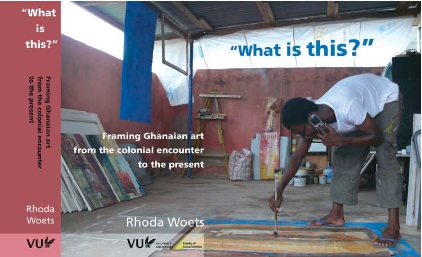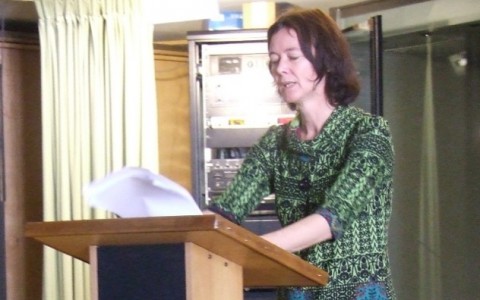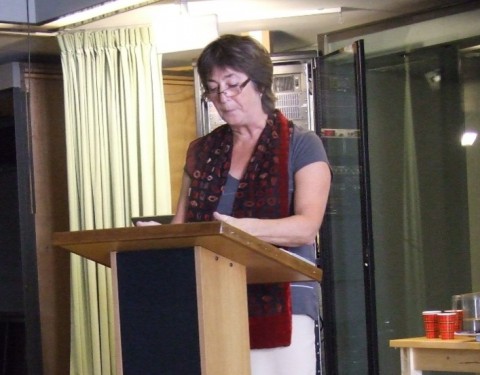
Cover of Rhoda Woets PhD thesis 'What is This? Framing Ghanaian art from the colonial encounter to the present'.
On September 28, the Vrije Universiteit of Amsterdam’s department of Social and Cultural Anthropology organized a seminar entitled ‘(Re)contextualising Art: Anthropology, Art History and the Museum’. During this afternoon anthropologists, art historians and curators gathered to discuss the current status of globalization and contemporary art.
Issues that were put up for discussion are the modes of evaluation to judge, acquire and display art from “outside.” What tools and criteria should curators use? Is an intimate knowledge of the social and cultural settings in which artists operate essential in valuing their work, as anthropologists tend to argue? A growing number of anthropologists study contemporary art(ists) but what have their contributions been to the formation of new art historical discourses? In short: how can anthropologists, art historians and curators come to a more fruitful cooperation and exchange?
Both art historian Gabriele Minelli and art historian Madelon van Schie wrote a report about the seminar. Gabriele Minelli’s report is published below. Click here to read Madelon van Schie’s report in Dutch.
Report: (Re)contextualising Art: Anthropology, Art History and the Museum
By: Gabriele Minelli
Rhoda Woets, who has just defended her Phd. thesis on Contemporary Ghanaian artists, opened the afternoon introducing the term ‘global art’ or ‘world art’ as a more politically correct version of what was previously called ‘non-western art’. Woets highlighted how African artists are presented in the international art scene; artists who are invited to the biennales of the last two decades are often part of the African diaspora and often not the ones who are actually living in the continent. An example is the recent book by Okwui Enwezor ‘Contemporary African Art Since 1980’ (Bologna 2009), where the Nigerian born curator selected mainly artists who are currently based in Europe or U.S.. Secondly, Woets emphasised the relationship between art historians and anthropologists in their approach of contemporary African art. She explained how the boundaries between the two disciplines are often uncertain, especially because the two fields often rely on the same theoretical framework.
The second lecturer, Maruška Svašek from the University of Belfast, pointed out that globalization and relations of power are not static structures. Svašek also described the attitude of the educated audience in contemporary India towards European art. Since 1966 there is an art commune in the village of Cholamandal, and recently a center for contemporary art has opened. The center is surrounded by a sculpture garden with work by international artists. The controversy started when the director of the institution decided to place a sculpture by the German artist Paul Schneider in front of the museum’s entrance. Schneider’s work seemed perfect for the location but the Indian people wanted an Indian artist to be selected and to represent the museum.
The third lecturer of the afternoon was John Picton from the School of African and Oriental Studies (SOAS) of the University of London. He spoke about his experience in West Africa and the art of the Yoruba people. The ethnic group of Yoruba is one of the biggest of the continent, located in Nigeria, but with large communities in the United Kingdom and the United States.
The last speaker of the morning was Kitty Zijlmans from the Art History department of the University of Leiden. She presented an overview of the situation of the Global Art in the education system, starting with the Netherlands: “In all the six departments of Art History in the Netherlands, not even one has a non-white staff member”. Therefore we can still speak of a look “from the West to the rest”. She continued exposing the evolution of the discipline, from the first professor in modern and contemporary art history in Leiden in 1963, to the introduction of the new Gender, Class and Ethnicity Studies during the late 1980s. But the turning point for Global Art was at the end of the millennium, when, with the influence of the post-colonial studies, the scientific community started asking “what about the other?”. The result is visible today, with a boom of World Art studies and the example of Leiden where students can follow classes of non-western art experts, even though these classes are still in the Culture and Language department and not in the Art History department.
The seminar ended with a roundtable discussion, including the previous lecturers and other speakers. Jelle Bouwhuis, head curator of SMBA, presented Project 1975 and the historical relationship between the Stedelijk Museum and global art. Another statement came from Georges Petitjean, curator of the Museum of the Contemporary Aboriginal Art of Utrecht, who described the collection as a result of an assembly of private donations and long term loans from other Dutch museums. The final word of the day was a quote of Michael Baxandall said by John Picton that remarked how much Art History and Anthropology have in common: “a work of art is a deposit of social relationship”.



2 Responses to Report ‘(Re)contextualising Art: Anthropology, Art History and the Museum’